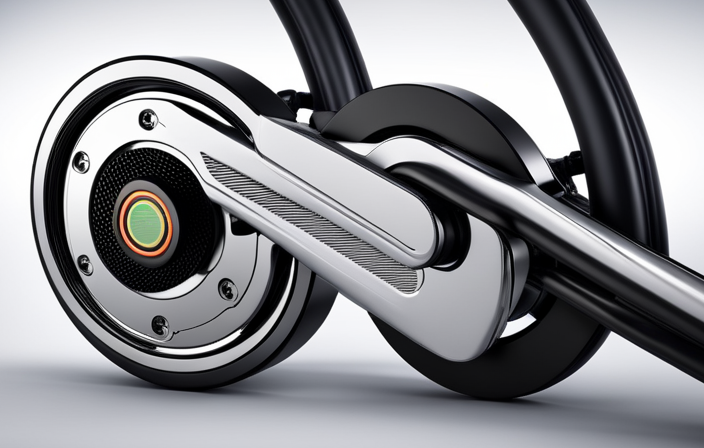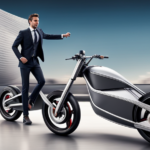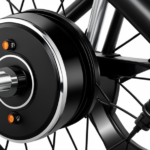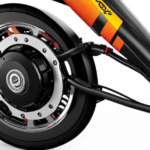As I pedal my electric bike, I’m intrigued by the unseen forces at work, propelling me forward with ease.
One such force is the hall sensor, a technological marvel that plays a crucial role in the functioning of electric bikes.
In this article, we will delve into the inner workings of the hall sensor, exploring its components, operation, and the advantages it brings to electric bike performance.
Get ready to unravel the mysteries behind this fascinating piece of technology.
Key Takeaways
- The hall sensor plays a crucial role in controlling power output and efficiency of electric bikes.
- It detects changes in the magnetic field produced by the motor’s rotor and provides feedback to the motor controller for accurate power delivery.
- The hall sensor consists of a semiconductor chip with three magnetic field sensors and generates a voltage proportional to the magnetic field strength.
- Advancements in hall sensor technology will improve the performance and reliability of electric bikes.
Introduction to Electric Bikes and their Growing Popularity
You might be surprised by the growing popularity of electric bikes and how they are revolutionizing the way people commute.
Electric bikes offer a greener alternative to traditional modes of transportation, as they are powered by rechargeable batteries and emit zero emissions.
In addition to their environmental benefits, electric bikes also provide several safety measures. They often come equipped with LED lights, reflective strips, and horn systems to ensure visibility and alert others on the road. Some models even have built-in GPS tracking devices for added security.
Understanding the basics of electric bike technology is crucial to fully appreciate their functionality and performance. From the motor and battery to the controller and hall sensor, each component plays a vital role in powering these efficient and eco-friendly vehicles.
Understanding the Basics of Electric Bike Technology
To understand the basics of electric bike technology, it’s important to grasp the concept of how the hall sensor operates. The hall sensor is a crucial component in electric bikes as it helps control the power output and efficiency of the motor.
Here are three key aspects of electric bike technology that rely on the hall sensor:
-
Electric bike battery technology: The hall sensor plays a vital role in monitoring the battery’s voltage and current levels, allowing the motor controller to adjust power accordingly. This ensures optimal battery usage and prolongs its lifespan.
-
Motor controller advancements: The hall sensor provides crucial feedback to the motor controller, enabling it to accurately determine the position of the motor’s rotor. This information is essential for the controller to deliver the appropriate amount of power to the motor, resulting in smooth and efficient operation.
-
Power modulation: By constantly monitoring the rotor position, the hall sensor allows for precise control of the motor’s power output. This enables smooth acceleration, efficient regenerative braking, and improved overall performance.
Understanding the function of the hall sensor in electric bikes sets the foundation for exploring its role in optimizing power delivery and enhancing riding experience.
Exploring the Function of the Hall Sensor in Electric Bikes
Take a moment to explore how the hall sensor functions in electric bikes.
The hall sensor plays a crucial role in determining the speed and position of the electric bike’s motor. It works by detecting changes in the magnetic field produced by the rotating magnets on the motor’s rotor. This information is then sent to the controller, which adjusts the power supplied to the motor accordingly.
The hall sensor consists of a small semiconductor chip with three magnetic field sensors. As the magnets pass by the sensors, they generate a voltage that is proportional to the strength of the magnetic field. This voltage is then converted into a digital signal by the sensor, allowing the controller to accurately measure the motor’s speed and position.
Understanding the function of the hall sensor is essential for potential applications and future advancements in electric bike technology.
In the subsequent section, we will delve into the components and operation of the hall sensor.
Hall Sensor Components and Operation
The hall sensor operates by detecting changes in the magnetic field produced by the rotating magnets on the motor’s rotor. It consists of several key components:
- Magnet: The hall sensor is positioned near a rotating magnet on the motor’s rotor.
- Hall element: This is a semiconductor material that is sensitive to changes in the magnetic field.
- Power supply: The hall sensor requires a power supply to function properly.
- Signal conditioning circuit: This circuit amplifies and filters the signals from the hall element.
- Output: The hall sensor produces a digital output signal that is used by the electric bike’s controller.
Hall sensor applications in electric bikes include monitoring the position and speed of the motor’s rotor, as well as providing feedback for motor control. Calibration of the hall sensor is important to ensure accurate readings.
Moving on to the advantages of using hall sensors in electric bikes…
Advantages of Using Hall Sensors in Electric Bikes
One advantage of using hall sensors in e-bikes is that they provide accurate and reliable feedback for motor control. Hall sensors can detect the position of the motor’s rotor by measuring the changes in magnetic field strength. This information is crucial for the controller to accurately control the motor’s speed and torque. By providing precise feedback, hall sensors enable smooth and efficient motor operation, resulting in improved performance and user experience.
In addition to accurate feedback, hall sensors offer several other benefits in electric bike motors and controllers. Firstly, they are compact and lightweight, making them ideal for integration into the limited space of an e-bike. Secondly, they have a long lifespan and require minimal maintenance, reducing overall operating costs. Lastly, hall sensors are highly reliable and immune to environmental factors such as temperature and vibration.
By utilizing hall sensors in electric bikes, manufacturers can ensure optimal motor performance and enhance the overall riding experience. However, despite these advantages, there are also limitations and challenges associated with hall sensors in e-bikes.
Limitations and Challenges of Hall Sensors in Electric Bikes
Despite their advantages, hall sensors in e-bikes face limitations and challenges that need to be addressed.
One limitation is their sensitivity to external magnetic fields, which can cause inaccurate readings and affect the overall performance of the sensor.
Additionally, hall sensors have a limited temperature range within which they can operate effectively. Extreme temperatures can lead to sensor malfunction or reduced accuracy.
Another challenge is the requirement for precise positioning of the magnet and sensor, as any misalignment can result in incorrect readings.
Moreover, hall sensors are susceptible to signal noise, which can interfere with the sensor’s ability to accurately detect the magnetic field changes.
These limitations and challenges highlight the need for further research and development in hall sensor technology to overcome these issues.
Recent technological advancements in hall sensor technology have aimed to address these limitations and improve the overall performance and reliability of hall sensors in electric bikes.
Recent Technological Advancements in Hall Sensor Technology
In recent years, there have been significant advancements in hall sensor technology. Particularly, there has been a comparison between hall effect sensors and inductive sensors.
Hall effect sensors offer several advantages over inductive sensors. These advantages include higher accuracy, faster response time, and better reliability in harsh environments.
Additionally, there have been developments in integrating hall sensors with other bike components. For example, they can now be integrated with the motor controller and the electric brake system. This integration enables more precise control and improved overall performance of electric bikes.
Hall Effect Sensors vs. Inductive Sensors
Hall effect sensors and inductive sensors are two different types of sensors used in electric bikes. Hall effect sensors, also known as magnetic field sensors, detect the presence of a magnetic field by measuring the Hall voltage that is generated when a current passes through a conductor placed in the field. On the other hand, inductive sensors, as the name suggests, rely on the principle of electromagnetic induction to detect the presence of metallic objects. They generate an oscillating magnetic field and measure the changes in the field caused by the presence of the object.
Here is a comparison table highlighting the main differences between Hall effect sensors and inductive sensors:
| Hall Effect Sensors | Inductive Sensors |
|---|---|
| Used in automobiles for speed and position sensing | Used in industrial automation for object detection |
| Measure Hall voltage | Measure changes in magnetic field |
| Non-contact sensing | Contact or proximity sensing |
| Highly precise and accurate | Less precise and accurate |
| Suitable for low speed applications | Suitable for high speed applications |
The integration of Hall sensors with other bike components, such as the motor and controller, allows for precise control and monitoring of the electric bike’s performance.
Integration of Hall Sensors with Other Bike Components
To fully utilize the capabilities of your electric bike, you can seamlessly incorporate Hall sensors with various other components for enhanced control and monitoring.
One important aspect to consider is sensor calibration, which ensures accurate readings and optimal performance. Calibration involves adjusting the sensor’s settings to match the specific requirements of your bike. This can be done through the bike’s control system or a dedicated calibration tool.
Another consideration is the impact on battery life. Hall sensors consume a minimal amount of power, but integrating them with other components may affect battery performance. It’s important to ensure that the sensors are properly connected and that their power consumption is within acceptable limits.
By integrating Hall sensors effectively, you can enhance the functionality of your electric bike.
Moving on to troubleshooting and maintenance tips for electric bike hall sensors…
Troubleshooting and Maintenance Tips for Electric Bike Hall Sensors
If you’re experiencing issues with your electric bike’s hall sensor, here are some troubleshooting and maintenance tips to help you out.
First, check the wiring connections and make sure they are secure and not damaged.
Inspect the hall sensor for any signs of physical damage or debris that may be obstructing its proper functioning.
Clean the sensor with a soft cloth or compressed air to remove any dirt or dust particles.
Additionally, ensure that the magnet alignment is correct and that it hasn’t shifted or become dislodged.
If the hall sensor is still not working properly, consider replacing it with a new one.
Regular maintenance practices such as keeping the sensor clean and checking for any loose connections can help prevent future issues.
Moving forward, advancements in electric bike sensor technology hold promise for improved reliability and performance.
Future Developments and Innovations in Electric Bike Sensor Technology
In discussing future developments and innovations in electric bike sensor technology, two key points come to mind.
The first point is advanced sensor integration and communication. This would involve the seamless integration of various sensors throughout the electric bike, allowing for real-time data collection and analysis. With advanced sensor integration and communication, the bike would be able to optimize performance and efficiency based on the rider’s preferences and riding conditions.
The second point is the potential for artificial intelligence and machine learning. This could revolutionize the way bikes interact with their riders and environment. With artificial intelligence and machine learning, electric bikes would have the ability to adapt and learn from the rider’s behaviors and preferences. This would provide a personalized riding experience.
Overall, these two points highlight the exciting possibilities for the future of electric bike sensor technology.
Advanced Sensor Integration and Communication
The integration and communication of advanced sensors is crucial for the operation of electric bikes. Sensor calibration is a key process that ensures accurate and reliable data collection. By calibrating the sensors, we can adjust their sensitivity and accuracy to optimize the performance of the electric bike.
Additionally, wireless sensor networks play a vital role in enabling seamless communication between different sensors and the bike’s control system. This allows for real-time monitoring and control, enhancing the overall efficiency and safety of the electric bike.
Furthermore, advanced sensor integration enables the bike to collect and analyze large amounts of data, paving the way for potential artificial intelligence and machine learning applications. With the ability to learn and adapt, electric bikes can further optimize their performance and provide a more personalized and efficient riding experience.
Potential for Artificial Intelligence and Machine Learning
You can explore the potential of artificial intelligence and machine learning in optimizing the performance of your electric bike through advanced sensor integration and data analysis. By applying artificial intelligence applications and machine learning algorithms to the data collected by the hall sensors on your electric bike, you can gain valuable insights and make informed decisions to enhance the performance and user experience.
Here is a visual representation of the ideas:
| Artificial Intelligence Applications | Machine Learning Algorithms | Data Analysis |
|---|---|---|
| Predictive maintenance | Reinforcement learning | Anomaly detection |
| Energy optimization | Supervised learning | Pattern recognition |
| Intelligent route planning | Unsupervised learning | Performance analysis |
These technologies can help you predict maintenance needs, optimize energy consumption, and plan intelligent routes. By leveraging the power of artificial intelligence and machine learning, you can take your electric bike to the next level of performance and efficiency. Transitioning to the subsequent section, the crucial role of hall sensors in enhancing electric bike performance and user experience becomes evident.
Conclusion: The Crucial Role of Hall Sensors in Enhancing Electric Bike Performance and User Experience
Overall, the crucial role of hall sensors in enhancing electric bike performance and user experience cannot be overstated. With advancements in sensor technology, hall sensors have had a significant impact on electric bike performance. Here are three key ways hall sensors contribute to this:
-
Accurate Speed Measurement: Hall sensors accurately detect wheel rotation, providing precise speed readings to the electric bike’s controller. This enables the controller to adjust the power output accordingly, ensuring a smooth and efficient riding experience.
-
Seamless Power Assistance: Hall sensors detect the position of the pedal crank, allowing the controller to deliver power assistance at the right time. This ensures seamless and responsive assistance, making the electric bike feel natural and intuitive to ride.
-
Efficient Motor Control: Hall sensors provide crucial feedback to the motor controller, enabling it to regulate the motor’s speed and torque accurately. This results in efficient power delivery, extending the battery life and optimizing overall electric bike performance.
In conclusion, hall sensors play a vital role in enhancing electric bike performance by providing accurate speed measurement, seamless power assistance, and efficient motor control. Their advancements in sensor technology have significantly improved the overall user experience.
Frequently Asked Questions
Is a hall sensor necessary for an electric bike to function?
No, a hall sensor is not necessary for an electric bike to function. However, it offers advantages such as precise motor control and speed sensing. Alternatives include using encoder sensors or relying solely on the motor controller for speed feedback.
Can a hall sensor be added to a non-electric bike to convert it into an electric bike?
Adding a hall sensor to a non-electric bike can convert it into an electric bike. However, compatibility may vary depending on the bike model. Hall sensors detect the rotation of the bike’s wheel and provide crucial data for the electric motor to function efficiently.
How long does a hall sensor typically last before needing to be replaced?
The longevity of a hall sensor in an electric bike depends on various factors such as usage, environmental conditions, and maintenance. On average, a hall sensor can last for several years before needing replacement. Regular maintenance can help extend its lifespan.
Are there any safety concerns or risks associated with using a hall sensor in an electric bike?
There are no safety concerns or risks associated with using a hall sensor in an electric bike. However, it is important to note the advantages and disadvantages of hall sensors, such as their reliability and sensitivity to magnetic fields.
Can a hall sensor be used to measure other parameters or variables in addition to speed in an electric bike?
Other uses for hall sensors in electric bike technology include measuring torque, cadence, and pedal assist level. Advantages of using a hall sensor for measuring speed include accuracy, simplicity, and reliability, while disadvantages include susceptibility to magnetic interference.
Conclusion
In conclusion, the Hall sensor plays a crucial role in enhancing the performance and user experience of electric bikes. By accurately detecting the position of the motor’s magnets, it allows for precise control over the bike’s speed and power output.
Additionally, recent technological advancements have led to improved Hall sensor technology, resulting in better efficiency and reliability.
However, it is important to note that while Hall sensors are essential for electric bike functionality, their performance can be affected by various factors such as dirt or misalignment. Regular maintenance and troubleshooting are necessary to ensure optimal sensor performance.
















